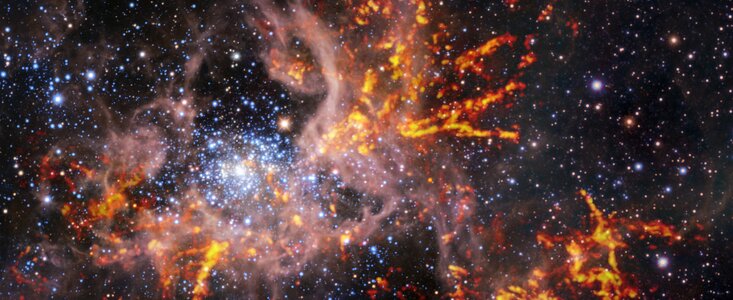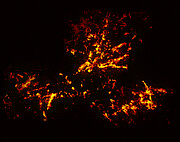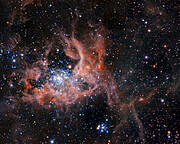Pressmeddelande
Tarantelnebulosans kosmiska nät – astronomer kartlägger intensiv stjärnbildning i en nebulosa utanför Vintergatan
15 juni 2022, Skurup

Astronomer har undersökt detaljerna i stjärnbildningsområdet 30 Doradus, också känt som Tarantelnebulosan, genom observationer med Atacama Large Millimeter/submillimeter Array (ALMA). Den nya bilden från Europeiska sydobservatoriet (ESO) visar nebulosans gasmoln med data från ALMA och ger en ny inblick i hur massiva stjärnor bildas i regionen.
“Gasen kan vara rester av tidigare mycket mer omfattande gasmoln som har splittrats av den intensiva energin som avges av unga och massiva stjärnor i närheten, en process som benämns återkoppling” säger Tony Wong, professor vid University of Illinois at Urbana-Champaign i USA. Wong ledde det forskningsprojekt som i dag presenterar sina resultat på ett möte arrangerat av American Astronomical Associations och som samtidgt publiceras i The Astrophysical Journal.
Astronomerna trodde inledningsvis att gasen skulle vara för tunn och utspridd på grund av den turbulenta återkopplingen för att kunna ansamlas till nya stjärnor. Men de nya observationerna visar att betydligt mer massiva gasfilament förekommer, där gravitationen är betydande. “Våra resultat indikerar att gravitationen kan påverka omgivningen starkt och leda till fortsatt stjärnbildning, även om stark återkoppling förekommer” säger Wong.
Tarantelnebulosan är belägen i Stora Magellanska molnet, en satellitgalax till Vintergatan på 170 000 ljusårs avstånd, och är en av de största och mest aktiva stjärnbildningsområdena i vårt galaktiska närområde. I dess centrum finns några av de mest massiva stjärnor som man känner till. Vissa är 150 gånger tyngre än solen vilket gör området perfekt för studier av hur gas kollapsar under sin egen gravitation för att bilda nya stjärnor.
“30 Doradus är unik då den är så närbelägen att vi i detalj kan studera hur stjärnbildningen går till, samtidigt som dess egenskaper liknar de i mycket avlägsna galaxer, som vi ser vid en tidpunkt då universum var mycket ungt” säger Guido de Marchi vid Europeiska rymdorganet ESA och medförfattare till artikeln. “Tack vare 30 Doradus kan vi studera hur stjärnor bildades för 10 miljarder år sedan, samtidigt som de flesta stjärnorna föddes”.
Även om de flesta tidigare studier av Tarantelnebulosan har fokuserat på dess centrala område har astronomerna känt till att stjärnbildning förekommer även på andra ställen. För att bättre förstå denna process utförde forskarlaget högupplösta observationer av ett stort område av nebulosan. Med ALMA uppmättes strålning från kolmonoxidgas i de utbredda kalla gasmolnen i nebulosan som är på väg att kollapsa till nya stjärnor, och hur molnen förändras när energirik strålning utsänds av de unga stjärnorna.
“Vi förväntade oss att området i nebulosans centrum, närmast de mest massiva stjärnorna, skulle visa de starkaste tecknen på gas som påverkades av återkoppling” säger Wong. “Men istället fann vi att gravitationen spelar en central roll i samtliga områden där återkoppling sker – åtminstone där gasen är tillräckligt tät.”
I den nya bilden som ESO presenterar i dag visas ALMA-datan tillsammans med en bild som tidigare tagits i infrarött ljus med ESO:s Very Large Telescope (VLT) och ESO:s Visible and Infrared Survey Telescope for Astronomy (VISTA). Den infraröda bilden visar ljusa stjärnor och rosafärgade moln av het gas, medan ALMA-datan visas som orange-gula filament av mycket kall och tät gas som en gång kan komma att kollapsa till nya stjärnor.
Den nya forskningsresultaten ger detaljerade ledtrådar till hur gravitationen beter sig i Tarantelnbulosans stjärnbildningsområden, men arbetet är långt ifrån avslutat. “Det finns mycket mer forskning kvar att göra med detta fantastiska dataset och vi gör det också offentligt tillgängligt för att uppmuntra andra forskare att studera det vidare”, avslutar Wong.
Mer information
Forskningsresultaten presenteras under American Astronomical Societys (AAS) 240:e möte vid en session med titeln “Stars, Their Environments & Their Planets” (onsdag 15 juni 19:15 CEST / 10:15 PT). Journalister är välkomna att följa presentationen live via AAS Press Office YouTube-kanal: https://www.youtube.com/c/AASPressOffice.
Resultaten presenteras också i artikeln “The 30 Doradus Molecular Cloud at 0.4 Parsec Resolution with ALMA: Physical Properties and the Boundedness of CO Emitting Structures” i tidskriften The Astrophysical Journal.
Forskarlaget utgörs av T. Wong (Astronomy Department, University of Illinois, USA [Illinois]), L. Oudshoorn (Leiden Observatory, Leiden University, Nederländerna [Leiden]), E. Sofovich (Illinois), A. Green (Illinois), C. Shah (Illinois), R. Indebetouw (Department of Astronomy, University of Virginia, USA och National Radio Astronomy Observatory, USA [NRAO]), M. Meixner (SOFIA-USRA, NASA Ames Research Center, USA), A. Hacar (Department of Astrophysics, University of Vienna, Austria), O. Nayak (Space Telescope Science Institute, USA [STSci]), K. Tokuda (Department of Earth and Planetary Sciences, Faculty of Sciences, Kyushu University, Japan och National Astronomical Observatory of Japan, National Institutes of Natural Sciences, Japan och Department of Physics, Graduate School of Science, Osaka Metropolitan University, Japan [Osaka]), A. D. Bolatto (Department of Astronomy och Joint Space Science Institute, University of Maryland, USA och NRAO Visiting Astronomer), M. Chevance (Astronomisches Rechen-Institut, Zentrum für Astronomie der Universität Heidelberg, Germany), G. De Marchi (European Space Research and Technology Centre, Netherlands), Y. Fukui (Department of Physics, Nagoya University, Japan), A. S. Hirschauer (STSci), K. E. Jameson (CSIRO, Space and Astronomy, Australia), V. Kalari (International Gemini Observatory, NSF’s NOIRLab, Chile), V. Lebouteiller (AIM, CEA, CNRS, Université Paris-Saclay, Université Paris Diderot, Frankrike), L. W. Looney (Illinois), S. C. Madden (Departement d’Astrophysique AIM/CEA Saclay, Frankrike), Toshikazu Onishi (Osaka), J. Roman-Duval (STSci), M. Rubio (Departamento de Astronomía, Universidad de Chile, Chile) och A. G. G. M. Tielens (Department of Astronomy, University of Maryland, USA och Leiden).
Europeiska sydobservatoriet (ESO) möjliggör för astronomer världen över att utforska universums mysterier. Vi designar, konstruerar och driver markbaserade observatorier av yppersta världsklass – som astronomer använder för att besvara spännande och utmanande frågor och för att sprida astronomisk kunskap – och driver internationella samarbeten inom astronomin. ESO startade som en mellanstatlig organisation 1962 och har i dag 16 medlemsländer (Belgien, Danmark, Finland, Frankrike, Irland, Italien, Nederländerna, Polen, Portugal, Schweiz, Spanien, Storbritannien, Sverige, Tjeckien, Tyskland och Österrike), tillsammans med Chile som värdland och Australien som en strategisk partner. ESO:s högkvarter och besökscenter med planetarium, ESO Supernova, ligger nära München i Tyskland, medan teleskopen är placerade i Atacamaöknen i Chile, en unik plats för astronomiska observationer. ESO driver tre observatorier i Chile: La Silla, Paranal och Chajnantor. Vid Paranal finns Very Large Telescope och Very Large Telescope Interferometer. Där finns även två kartläggningsteleskop: VISTA som arbetar i infrarött ljus och VLT Survey Telescope som observerar i synligt ljus. Vid Paranal kommer även ESO att placera och driva Cherenkov Telescope Array South, världens största och känsligaste gammastrålningsteleskop. Tillsammans med internationella partners driver ESO de två anläggningarna APEX och ALMA på Chajnantorplatån som observerar himlen i millimeter- och submillimetervåglängder. Vid Cerro Armazones, nära Paranal, bygger vi för närvarande ESO:s Extremely Large Telescope, ”världens största öga mot himlen”. Från kontoret i Santiago, Chile, stödjer vi verksamheten i landet och samverkar med det chilenska samhället och våra samarbetspartners.
Atacama Large Millimeter/submillimeter Array (ALMA) är en internationell astronomisk anläggning som drivs i partnerskap mellan ESO, National Science Foundation (NSF, USA) och National Institutes of Natural Sciences (NINS, Japan), tillsammans med Chile. ALMA finansieras av ESO genom dess medlemsstater, av NSF i samarbete med National Research Council of Canada (NRC) och Ministry of Science and Technology (MOST), och av NINS i samarbete med Academia Sinica (AS) i Taiwan och Korea Astronomy and Space Science Institute (KASI). Konstruktionen och driften av ALMA leds av ESO för dess medlemsstater, av National Radio Astronomy Observatory (NRAO) genom Associated Universities, Inc. (AUI) för Nordamerika, och av National Astronomical Observatory of Japan (NAOJ) för Östasien. Joint ALMA Observatory (JAO) står för övergripande ledning och organisation under konstruktionen, driftsättningen och driften av ALMA.
Länkar
- Forskningsartikel
- Pressmeddelande från NRAO
- Foton av ALMA
- Foton av VISTA
- Foton av VLT
- Andra bilder av Tarantelnebulosan
- För journalister: Prenumerera på pressmeddelanden under embargo på svenska
- För astronomer: Berätta om din forskning!
Kontakter
Tony Wong
Astronomy Department, University of Illinois
Urbana-Champaign, IL, USA
Tel: +1 217 244 4207
E-post: wongt@illinois.edu
Guido De Marchi
European Space Research and Technology Centre, European Space Agency
Noordwijk, Netherlands
Tel: +31 71 565 8332
Mobil: +31 6 5081 6906
E-post: gdemarchi@esa.int
Bárbara Ferreira
ESO Media Manager
Garching bei München, Germany
Tel: +49 89 3200 6670
Mobil: +49 151 241 664 00
E-post: press@eso.org
Johan Warell (Presskontakt för Sverige)
ESO:s nätverk för vetenskaplig kommunikation
Skurup, Sverige
Tel: +46-706-494731
E-post: eson-sweden@eso.org
Om pressmeddelandet
| Pressmeddelande nr: | eso2209sv |
| Namn: | 30 Doradus, Tarantula Nebula |
| Typ: | Local Universe : Nebula : Type : Star Formation |
| Facility: | Atacama Large Millimeter/submillimeter Array |
| Science data: | 2022ApJ...932...47W |
Our use of Cookies
We use cookies that are essential for accessing our websites and using our services. We also use cookies to analyse, measure and improve our websites’ performance, to enable content sharing via social media and to display media content hosted on third-party platforms.
ESO Cookies Policy
The European Organisation for Astronomical Research in the Southern Hemisphere (ESO) is the pre-eminent intergovernmental science and technology organisation in astronomy. It carries out an ambitious programme focused on the design, construction and operation of powerful ground-based observing facilities for astronomy.
This Cookies Policy is intended to provide clarity by outlining the cookies used on the ESO public websites, their functions, the options you have for controlling them, and the ways you can contact us for additional details.
What are cookies?
Cookies are small pieces of data stored on your device by websites you visit. They serve various purposes, such as remembering login credentials and preferences and enhance your browsing experience.
Categories of cookies we use
Essential cookies (always active): These cookies are strictly necessary for the proper functioning of our website. Without these cookies, the website cannot operate correctly, and certain services, such as logging in or accessing secure areas, may not be available; because they are essential for the website’s operation, they cannot be disabled.
Functional Cookies: These cookies enhance your browsing experience by enabling additional features and personalization, such as remembering your preferences and settings. While not strictly necessary for the website to function, they improve usability and convenience; these cookies are only placed if you provide your consent.
Analytics cookies: These cookies collect information about how visitors interact with our website, such as which pages are visited most often and how users navigate the site. This data helps us improve website performance, optimize content, and enhance the user experience; these cookies are only placed if you provide your consent. We use the following analytics cookies.
Matomo Cookies:
This website uses Matomo (formerly Piwik), an open source software which enables the statistical analysis of website visits. Matomo uses cookies (text files) which are saved on your computer and which allow us to analyze how you use our website. The website user information generated by the cookies will only be saved on the servers of our IT Department. We use this information to analyze www.eso.org visits and to prepare reports on website activities. These data will not be disclosed to third parties.
On behalf of ESO, Matomo will use this information for the purpose of evaluating your use of the website, compiling reports on website activity and providing other services relating to website activity and internet usage.
Matomo cookies settings:
Additional Third-party cookies on ESO websites: some of our pages display content from external providers, e.g. YouTube.
Such third-party services are outside of ESO control and may, at any time, change their terms of service, use of cookies, etc.
YouTube: Some videos on the ESO website are embedded from ESO’s official YouTube channel. We have enabled YouTube’s privacy-enhanced mode, meaning that no cookies are set unless the user actively clicks on the video to play it. Additionally, in this mode, YouTube does not store any personally identifiable cookie data for embedded video playbacks. For more details, please refer to YouTube’s embedding videos information page.
Cookies can also be classified based on the following elements.
Regarding the domain, there are:
- First-party cookies, set by the website you are currently visiting. They are stored by the same domain that you are browsing and are used to enhance your experience on that site;
- Third-party cookies, set by a domain other than the one you are currently visiting.
As for their duration, cookies can be:
- Browser-session cookies, which are deleted when the user closes the browser;
- Stored cookies, which stay on the user's device for a predetermined period of time.
How to manage cookies
Cookie settings: You can modify your cookie choices for the ESO webpages at any time by clicking on the link Cookie settings at the bottom of any page.
In your browser: If you wish to delete cookies or instruct your browser to delete or block cookies by default, please visit the help pages of your browser:
Please be aware that if you delete or decline cookies, certain functionalities of our website may be not be available and your browsing experience may be affected.
You can set most browsers to prevent any cookies being placed on your device, but you may then have to manually adjust some preferences every time you visit a site/page. And some services and functionalities may not work properly at all (e.g. profile logging-in, shop check out).
Updates to the ESO Cookies Policy
The ESO Cookies Policy may be subject to future updates, which will be made available on this page.
Additional information
For any queries related to cookies, please contact: pdprATesoDOTorg.
As ESO public webpages are managed by our Department of Communication, your questions will be dealt with the support of the said Department.





